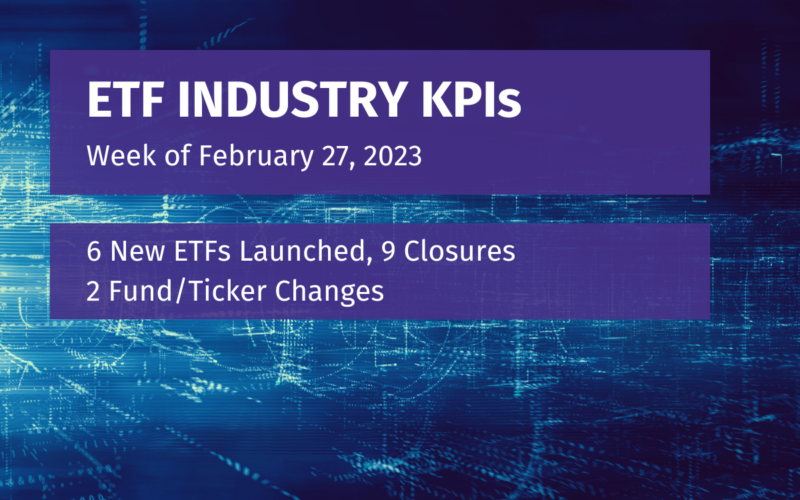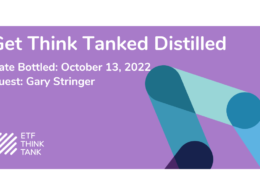Most investors are familiar with covered call strategies. These are the ones that own a long position in a security while simultaneously writing call options on it an attempt to boost income. A lot of them may produce annualized yields of 10% or more. How about two examples that generate a current yield of around 65%?[1] Jay Pestrichelli, the CEO & Co-Founder of Zega Financial, has such a product. He joins the ETF Think Tank to discuss the pair of new “YieldMax” ETFs and how they work.
One of the strategies used to manage the YieldMax Innovation Option Income Strategy ETF (OARK) writes covered calls on innovation stocks, while the other strategy is used to manage the YieldMax TSLA Option Income Strategy ETF (TSLY) uses options on the common stock of Tesla. From a structural standpoint, the covered call position is entirely synthetic. The OARK fund will simultaneously buy ARK Innovation ETF (“ARKK”) European style call options and sell ARKK put options to try to replicate the price movements of the fund. It will then write very short-term call options on ARKK in an attempt to generate high income. The funds uses weekly exchange traded options that are approximately 5-15% out of the money, hold them for a few days until they expire, and repeat the process the next week, collecting the options premium each time.
The genesis of these ultra-high yield strategies began with a change in the marketplace when leveraged/inverse single stock ETFs started launching. Pestrichelli saw that everybody started chasing the same ideas around the same few stocks and he initially looked at trying to generate synthetic yield on Berkshire Hathaway. From there, it evolved into running the same strategy on higher volatility names in an effort to generate really high yields.
Pestrichelli aims to create these strategies using primarily high volatility securities because that is where the biggest yield opportunities are. Because Tesla and innovation stocks are so volatile, the funds can currently generate current yields of around 65% annualized. He says that one of the big advantages of these products is that they aren’t about being bullish or bearish. They’re simply about being volatile. It’s about expecting volatility in order to gain potential yield.
While the yields are the big feature, it’s important to remember that shareholders are still owning a synthetic long position in the underlying security. Tesla stock recently dropped from $190 down to about $110. Shareholders will still experience that capital by owning the fund. The yield will offset some of the loss, but the total return involves more than just the yield. Similarly, if Tesla were to go from $100 to $200, shareholders will likely miss out on most, if not all, of the gain because the written options will be called. The underlying share price can fluctuate significantly.
Pestrichelli thinks that creating one of these strategies on top of a bond fund may make sense for some investors. He looked at junk bonds as an option, but notes that the dynamics of options pricing and behavior on fixed income is a little different. Options already reflect a share price drop from a dividend distribution, and he found that there wasn’t as much of a lift looking at a junk bond ETF because of this. The approach would need to be a little different.
Other key takeaways:
- The funds generally target an annualized current yield of 65%. If volatility goes up, Pestrichelli says they’ll aim for higher yield and vice versa.
- What would a yield look like on one of these strategies for GameStop or Bed Bath & Beyond? The share price volatility makes it more untenable, but based on volatility levels it would probably be around 180%, in Pestrichelli’s opinion.
- From a regulatory standpoint, the Treasuries position is held to fulfill diversification requirements and meet funding requirements for the written options.
- Pestrichelli says that these funds are more appropriate for modestly risk-seeking individuals. He probably wouldn’t put older or risk-averse investors into this, but they’re exploring the opportunity to do a yield max strategy on a lower risk stock in exchange for a lower yield.
SEC 30 Day Yield as of 1/31/2023[2]
OARK -9.18%
TSLY -10.88%
For SEC Standardized Performance click here:
OARK or TSLY
The performance data quoted represents past performance. Past performance does not guarantee future results. The investment return and principal value of an investment will fluctuate so that an investor’s shares, when sold or redeemed, may be worth more or less than their original cost and current performance may be lower or higher than the performance quoted. Performance current to the most recent month-end can be obtained by calling (866) 322-3101.
OARK Prospectus
TSLY Prospectus
A European Option is another version of an options contract that limits rights exercise to the day of expiration only.
[1] Reflects current yields as of 02/07/2023, for the YieldMax Innovation Option Income Strategy ETF (OARK) and YieldMax TSLA Option Income Strategy ETF (TSLY). The Current Yield is the annual yield an investor would receive if the most recently declared distribution, which includes option income, remained the same going forward. The Current Yield is calculated by multiplying an ETF’s Distribution per Share by twelve (12), and dividing the resulting amount by the ETF’s most recent NAV. The Current Yield represents a single distribution from the ETF and does not represent its total return.
[2] The 30-Day SEC Yield represents net investment income, which excludes option income, earned by such ETF over the 30-Day period ended 1/31/2023, expressed as an annual percentage rate based on such ETF’s share price at the end of the 30-Day period. All YieldMax ETFs have a gross expense ratio of 0.99%.
Important Information
All investments involve risk, including possible loss of principal.
Before investing you should carefully consider the Fund’s investment objectives, risks, charges and expenses. This and other information is in the prospectus. Please read the prospectuses carefully before you invest.
YieldMax ETFs seek to generate monthly income by selling/writing call options on single company stock or single ETF exposures. YieldMax ETFs pursue a strategy that aims to harvest compelling yields from assets that are not typically associated with monthly income. Selling/writing calls will limit an ETF’s participation in the appreciation of the underlying security.
Derivatives Risk. Derivatives are financial instruments that derive value from the underlying reference asset or assets, such as stocks, bonds, or funds (including ETFs), interest rates or indexes. The Fund’s investments in derivatives may pose risks in addition to, and greater than, those associated with directly investing in securities or other ordinary investments, including risk related to the market, imperfect correlation with underlying investments or the Fund’s other portfolio holdings, higher price volatility, lack of availability, counterparty risk, liquidity, valuation, and legal restrictions.
Options Contracts. The use of options contracts involves investment strategies and risks different from those associated with ordinary portfolio securities transactions. The prices of options are volatile and are influenced by, among other things, actual and anticipated changes in the value of the underlying instrument, including the anticipated volatility, which are affected by fiscal and monetary policies and by national and international political, changes in the actual or implied volatility or the reference asset, the time remaining until the expiration of the option contract and economic events.
Elevate Shares is the parent brand to YieldMax.
The YieldMax ETFs are distributed by Foreside Fund Services, LLC. Foreside is not affiliated with Elevate Shares, YieldMax or Toroso.
The material provided here is for informational purposes only and should not be considered an individualized recommendation or personalized investment advice. The investment strategies mentioned here may not be suitable for everyone. Each investor needs to review an investment strategy for his or her own particular situation before making any investment decision.
All expressions of opinion are subject to change without notice in reaction to shifting market conditions. Data contained herein from third party providers is obtained from what are considered reliable sources. However, its accuracy, completeness or reliability cannot be guaranteed.
Examples provided are for illustrative purposes only and not intended to be reflective of results you can expect to achieve.
The value of investments and the income from them can go down as well as up and investors may not get back the amounts originally invested, and can be affected by changes in interest rates, in exchange rates, general market conditions, political, social and economic developments and other variable factors. Investment involves risks including but not limited to, possible delays in payments and loss of income or capital. Neither Toroso nor any of its affiliates guarantees any rate of return or the return of capital invested. This commentary material is available for informational purposes only and nothing herein constitutes an offer to sell or a solicitation of an offer to buy any security and nothing herein should be construed as such. All investment strategies and investments involve risk of loss, including the possible loss of all amounts invested, and nothing herein should be construed as a guarantee of any specific outcome or profit. While we have gathered the information presented herein from sources that we believe to be reliable, we cannot guarantee the accuracy or completeness of the information presented and the information presented should not be relied upon as such. Any opinions expressed herein are our opinions and are current only as of the date of distribution, and are subject to change without notice. We disclaim any obligation to provide revised opinions in the event of changed circumstances.
The information in this material is confidential and proprietary and may not be used other than by the intended user. Neither Toroso or its affiliates or any of their officers or employees of Toroso accepts any liability whatsoever for any loss arising from any use of this material or its contents. This material may not be reproduced, distributed or published without prior written permission from Toroso. Distribution of this material may be restricted in certain jurisdictions. Any persons coming into possession of this material should seek advice for details of and observe such restrictions (if any).












